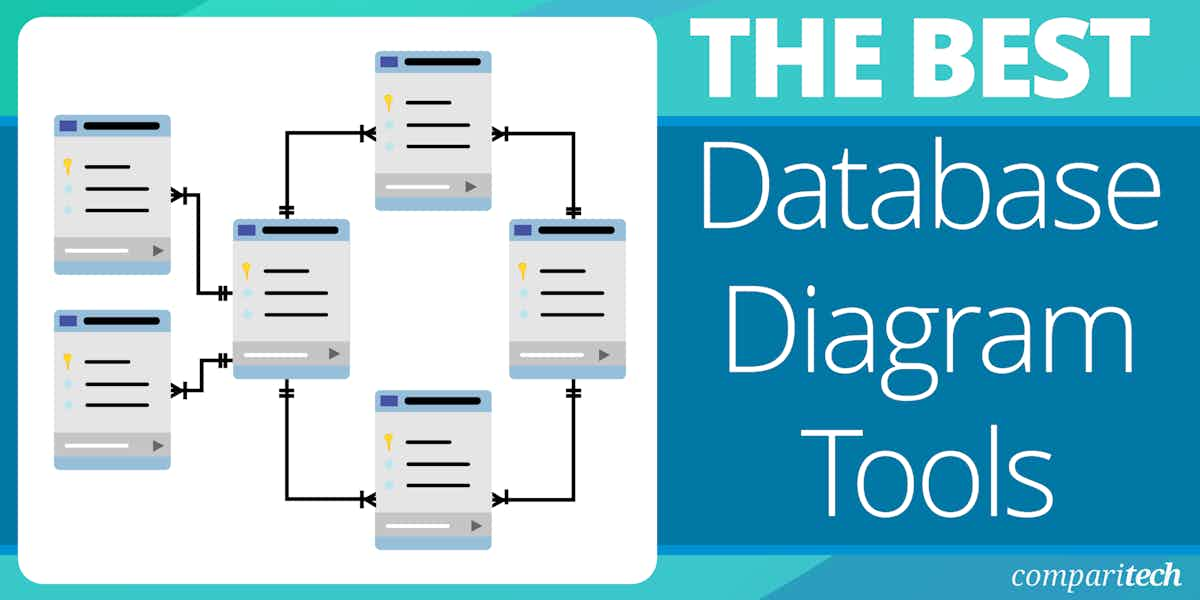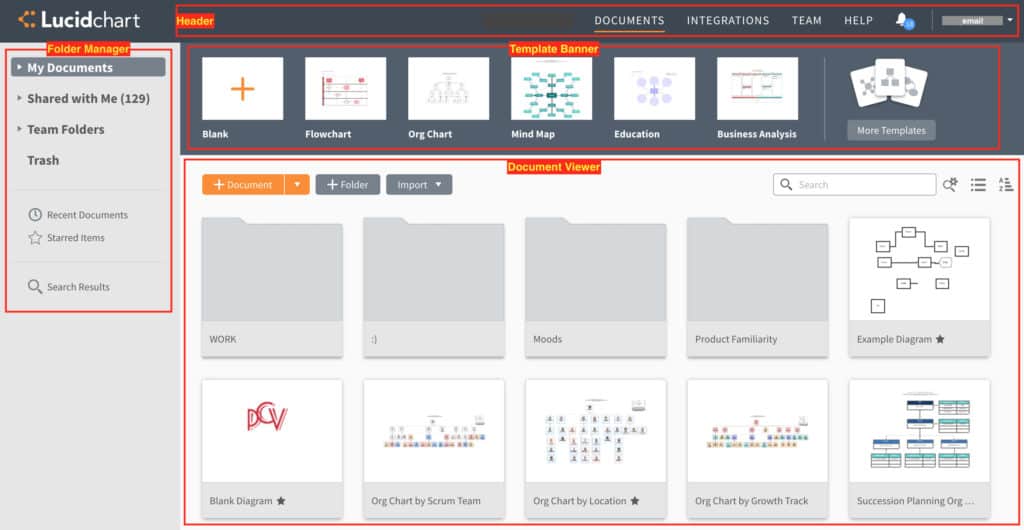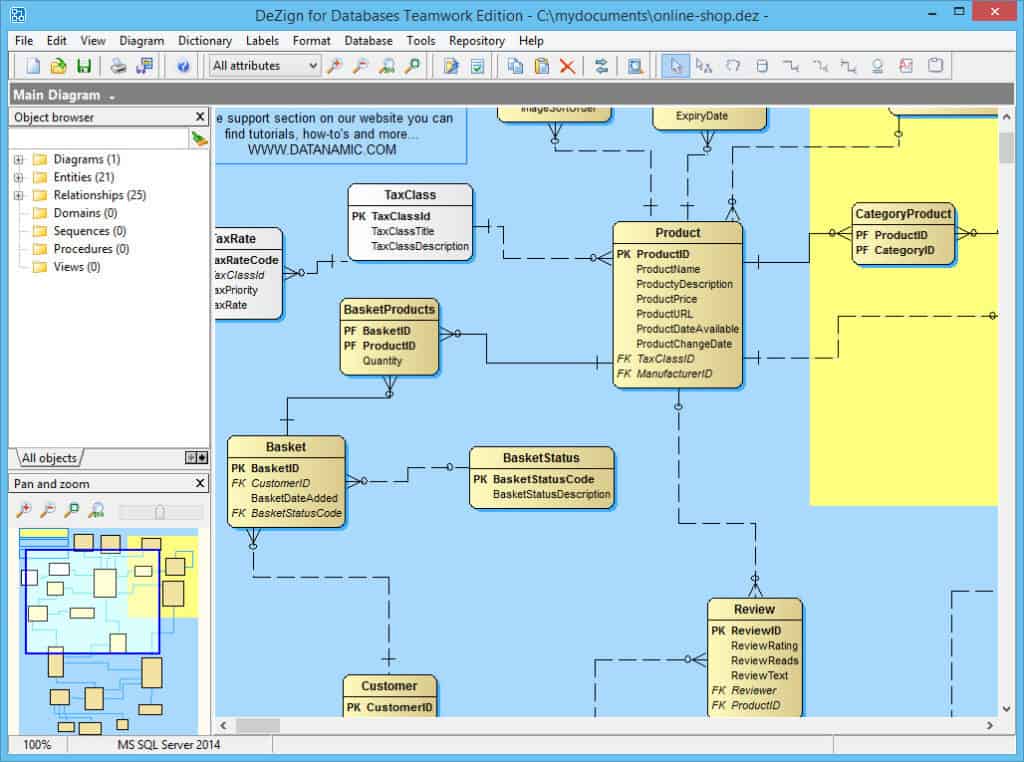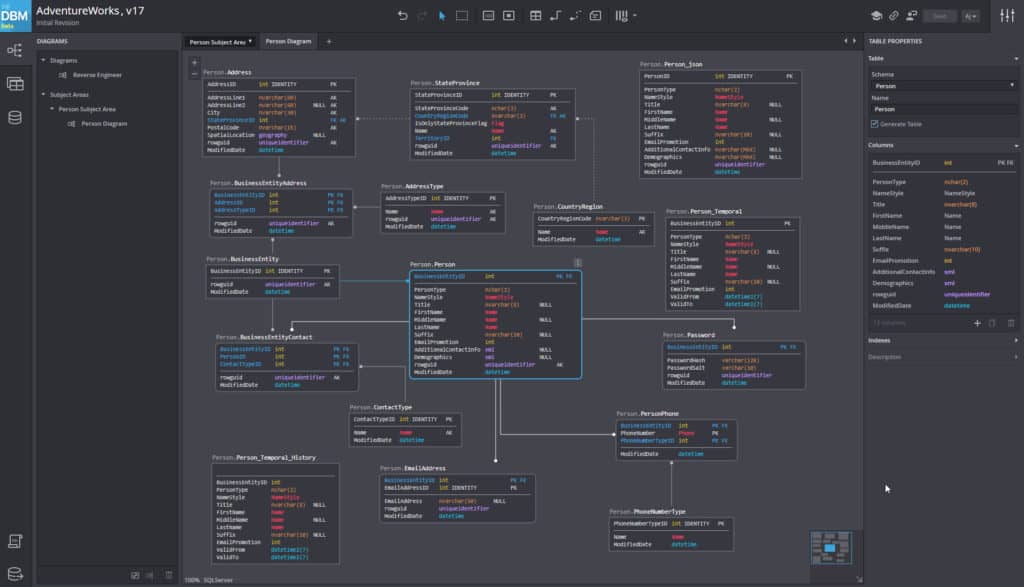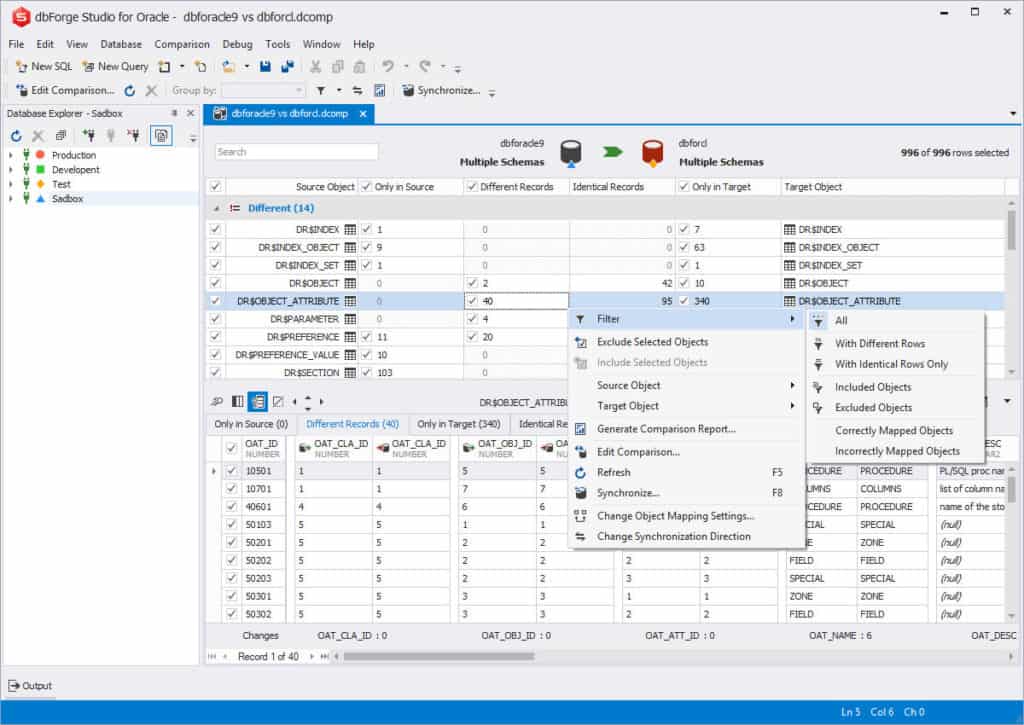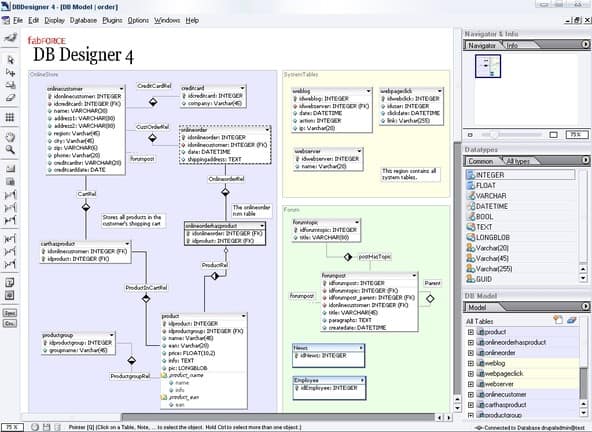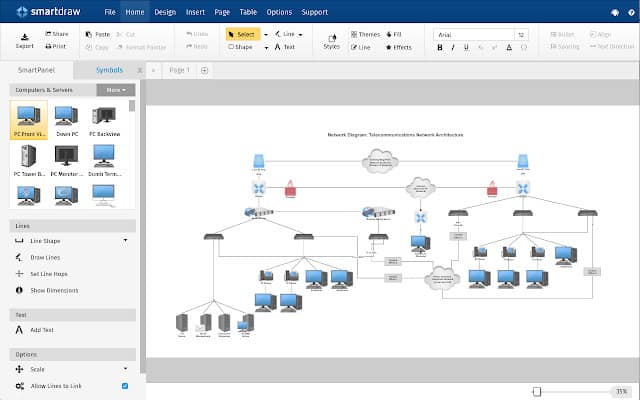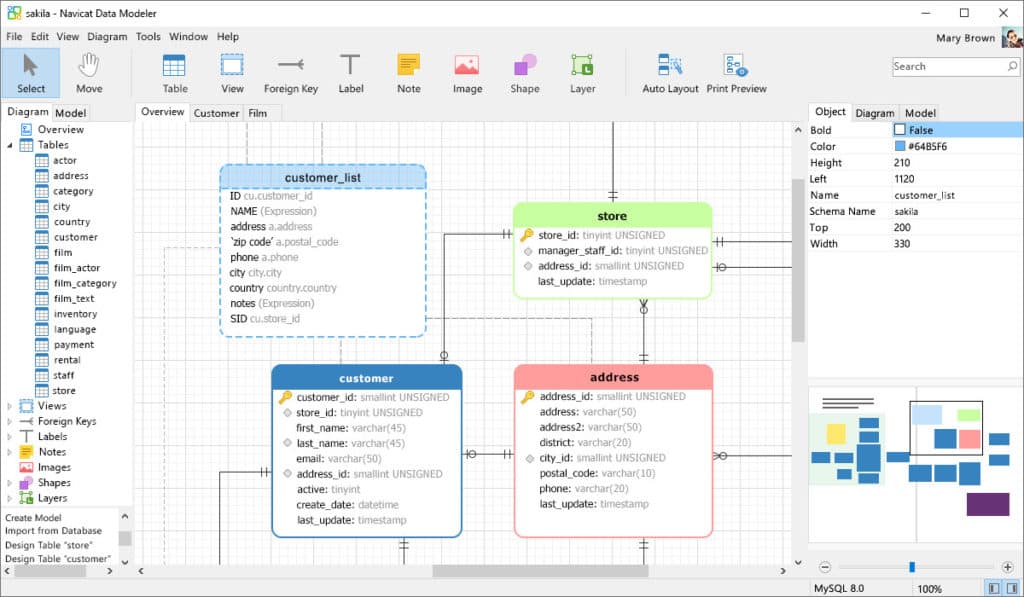Diagramming plays a critical role in database management, serving as a visual framework for understanding, designing, and maintaining databases
By offering a clear representation of the structure and relationships within a database, diagrams are invaluable for both initial design and ongoing operations.
Here is our list of the best database diagram tools:
- Lucidchart This visual database designer is available online and it includes collaboration features to help you create, amend, and share database designs. Available in free and paid versions.
- DeZign Database modeler and diagram tool with synchronization capabilities.
- SqlDBM Online Database diagram tool with forward and reverse engineering so you can import from an existing database.
- dBForge Studio for SQL Server A database diagram tool for SQL Server that has a visual designer tool and schema synchronization.
- DB Designer Online database diagram tool and modeling tool for MySQL, SQL Server, PostgreSQL, Oracle, and SQLite.
- DbSchema Database diagram and schema synchronization for SQL and NoSQL databases.
- SmartDraw Database diagram tool that acts as an alternative to Microsoft Visio with Intelligent Formatting and content templates.
- Navicat Data Modeler Database diagram MySQL, Oracle, MariaDB, SQL Server, PostgreSQL, and SQLite.
Designing a Database with Diagrams
When creating a new database, entity-relationship diagrams (ERDs) are among the most commonly used tools. ERDs depict entities (tables) and their relationships, including attributes such as primary and foreign keys. This visual approach makes it easier to identify and define relationships, such as one-to-one, one-to-many, or many-to-many connections, before implementation. Diagramming also highlights normalization opportunities, ensuring data is efficiently organized to reduce redundancy and improve integrity.
Other diagram types, like data flow diagrams (DFDs), help outline how data moves through a system, identifying inputs, outputs, and processing stages. These diagrams are particularly useful for understanding workflows and ensuring alignment between database design and business processes.
Maintaining Database Instances
Once a database is operational, diagrams provide ongoing value in maintaining and troubleshooting instances. They act as a roadmap for administrators to monitor schema changes, optimize queries, and identify potential bottlenecks. For example, updated diagrams can reveal outdated relationships or unused tables, enabling more efficient maintenance.
Supporting Application Development
Diagrams are also crucial for developers building applications that interact with the database. A clear depiction of tables, relationships, and constraints ensures developers understand how to access and manipulate data without introducing errors. Additionally, visual aids can bridge communication between technical and non-technical stakeholders, streamlining collaborative development efforts.
In summary, diagramming is fundamental to effective database management, from initial design to long-term maintenance and application development, ensuring clarity, efficiency, and alignment with organizational goals.
The best database diagram tools
Our methodology for selecting a database diagram tool
We reviewed the market for database diagram creation systems and analyzed tools based on the following criteria:
- The ability to interface with DBMSs to extract schemas from existing instances
- Suitable symbol library for EDR creation and schema diagrams
- Data dictionary compilation
- A utility to correct normalization errors
- The option to extract object creation scripts
- A free trial or a demo system for a cost-free assessment period
- A good deal, represented by a comprehensive tool that cuts database production time at a fair price
With these selection criteria in mind, we surveyed the market for database diagram tools and identified systems that we are happy to recommend.
1. Lucidchart
Lucidchart is a visual database design tool that allows you to automatically create, edit, and import database diagrams. The software is compatible with databases such as MySQL, PostgreSQL, Oracle, and SQL Server. You can select from a library of shapes to build a new database.
Key Features
- Online system: Access it through a website
- Free account available: Limited to three charts per month
- Create and edit charts: Create an ERD and convert it into database objects
- Import charts: Convert them to Lucidchart format, adjust them, and save them
- Generate a database: The tool generates create scripts and runs them in the database
Why do we recommend it?
Lucidchart is a chart creation tool that can be used for a range of business purposes, including process flow charts and organizational charts. The package provides a library of icons for the creation of Entity Relationship Diagrams. It won’t query the database and generate a diagram for you.
Once you’ve finished diagraming your database you can export it to your DBMS. Alternatively, you can publish and share it with other members of your team through another integrated service. Lucidchart has integrations for Google, Dropbox, box, Jive, Okta, one login, Microsoft Office, Microsoft Azure, Slack, HipChat, JIRA, and more.
Who is it recommended for?
Lucidchart can be used during the database creation phase and it is good for communicating ideas among project members and stakeholders. The system is also useful for mapping preliminary research for conceptual design.
Pros:
- Coordinate the chart and the database: Make changes to the database through Lucidchart
- Compatible with the major RDBMSs: MySQL, MariaDB, SQL Server, Oracle, and PostgreSQL
- Chart sharing: Comments and approvals are possible
- Revision history: Makes rollback possible
- Presentation mode: Visuals can be transmitted digitally
Cons:
- No on-premises version: This tool is only available online
There are four versions of Lucidchart: Free, Individual, Team, and Enterprise. The Free version is designed for a single user, as is the Individual plan. An Individual account costs $7.95 (£6.00) per month when paid annually. The Free account only lets you create three charts per month but the paid version of that account has no limit on your turnover.
Collaboration features are reserved for the two higher plans. The Team version starts at $9 (£6.79) per user per month and requires a minimum of three users. The Enterprise version is priced by negotiation and adds features like centralized admin control and document retention. You can sign up for a free trial of the Individual or Team account or just access the Free plan.
EDITOR'S CHOICE
Lucidchart is our top pick for a database diagram tool because it is hosted as a website, so it can be accessed from anywhere and doesn’t need any software installed. The Lucidchart system has a visual diagram creator that can also interpret existing designs imported into the system. It is very easy to create database designs with this tool and there are mechanisms within the package that let you share your design and even invite others to participate in the database design creation process. The tool has a free version.
OS: Web based
2. DeZign
DeZign is a data modeling and database diagram tool that enables the user to create and model databases. The tool automatically generates diagrams for popular databases. The tool uses entity-relationship diagrams to display the relationships between database entities. The database diagram editor is drag-and-drop so you can object elements easily.
Key Features
- Compatible with many RDBMSs: Oracle, MS SQL Server, MySQL, PostgreSQL, MS Access and many more
- ERD creation: Develop a database by designing an ERD
- Generate databases: The tool creates objects in the database
- Visual interface: Maintain an ERD that reflects your database objects
Why do we recommend it?
DeZign is a nice combination of an ERD generator and a graphical editor. The tool will access a database schema and extract out object descriptions. DeZign can also scan through object generation scripts to derive the database design. It then draws up the Entity Relationship Diagram from that existing instance. The designer can then manually adjust the ERD to add on new objects.
If you need to pass your databases on you can create customized reports and export them in PDF, Word, and HTML formats. You can also export diagrams as images in png, jpeg-image, bitmap, gif-image, and Windows metafile.
Who is it recommended for?
This system is a useful tool for documenting an existing database. The DeZign system can also spot differences between a design for a database and the actual structures in the database. The only problem with this option is that it can’t generate object-creation scripts.
Pros:
- Highlights design errors: Resolves many-to-many relationships
- Easy candidate key identification: scans for possible keys
- Defines keys: Generates unique key fields and identifiers
- Reverse engineering: Reads an existing database and creates an ERD
Cons:
- No online version: Runs on Windows
DeZign for Databases is a software package that installs on Windows. It is available for a perpetual license or on a subscription. The subscription rate is available per month or per year. The cheapest option is to buy the tool on a yearly license.
There are four editions available with progressively longer features lists. The cheapest plan is the Standard edition, which costs $195 (£154.06) per year or $25 (£19.75) per month. For the reverse engineering capability, you need to move up to the Professional edition. This is priced at $595 (£470.10) per year or $75 (£59.26) per month. To be able to update the database structure from your model, you need to get the Expert edition. This subscription costs $795 (£628.11) per year or $100 (£79.01) per month. Datanamic provides an All Products bundle that includes DeZign for Databases and that costs $1,095 (£865.13) for a yearly subscription or $135 (£106.66) per month. All of these prices are per user.
Datanamic offers a 14-day free trial of DeZign for Databases Expert Edition.
3. SqlDBM
SqlDBM is an SQL diagram tool and database modeler that you can use to create and import databases. SqlDBM is compatible with SQL Server, MySQL, PostgreSQL, Snowflake, and Amazon Redshift. You can create database objects such as tables, objects, and relationships through the intuitive GUI (which is available in dark and light themes).
Key Features
- Free tool: Start designing a database without paying
- Pay to save: You can’t save designs in the free version
- Upload designs: Import ERDs from other tools
Why do we recommend it?
SqlDBM is pretty hard to beat because it can model existing databases, support new database design, and also generate out object creation scripts. The fact that this tool is available online is another advantage because that lets team members in different locations access the design as it is developed.
One of the most useful features offered by the GUI is View Modes. View Modes allow you to change the perspective of your databases and choose which elements you see on the screen. For example, Table Names only and Keys only options enable you to prioritize monitoring particular elements.
To support collaboration, SqlDBM allows you to share diagrams and changes with other users with a URL. Just copy and paste the link into an email and your team will be able to click through to your diagram. All versions of your diagrams are saved in the cloud so if you ever need to revert to an earlier version you can do this.
Who is it recommended for?
This system is suitable for anyone who is developing a database. The full version that includes script generation is expensive, so small businesses would find that expense difficult to justify. That plan is only available for an annual subscription, so it is a suitable tool for a consultancy or a large organization.
Pros:
- Reverse engineer: Connect to a database and generate an ERD
- Multiple RDBMSs: SQL Server, MySQL, PostgreSQL, Snowflake, and Amazon Redshift
- Design automation: Suggests relationships and keys
Cons:
- Expensive: Beyond the budget of small businesses
There are four editions of sqlDBM: Free, Starter, Small Enterprise, and Standard Enterprise. The Free version can be used anonymously but you can have only one active project at a time and you can’t save your design. The Starter plan costs $2,000 (£1,580) per seat per year with a minimum of two seats. The prices for the other two paid plans are not published. You can trial the sqlDBM system by accessing the Free system.
4. dBForge Studio for SQL Server
dBForge Studio for SQL Server is an SQL management tool with diagram capabilities. The user can create diagrams of a database from the Data Explorer with drag-and-drop. The container feature allows the user to store objects that are logically related in one place. The user places tables inside a container then minimizes it. Containers are ideal for those companies working with large databases.
Key Features
- Supports SQL Server: Designed to interface with Microsoft’s SQL command set.
- Other DBMSs: Access other flavors for use with MySQL/MariaDB, PostgreSQL, and Oracle
- Database frontend: Connect to a database and see all of its objects
Why do we recommend it?
There are extensive features in dbForge Studio for SQL Server that make this a more widely used system than just a database diagramming system. The tool can also be used to develop SQL statements and it includes services to help optimize database structures. For database design, this tool gives you the three most important services: instance extraction for modeling; manual design tools; and script generation for database creation.
The platform also offers the ability to manage logical relations between database tables through the Virtual Relation Manager. The manager allows the user to view visual displays of logical relations and edit them. The user can then use these virtual relations to generate schema scripts based upon selected table relations.
Once you’ve finished designing your diagram you can print it. You have complete control over the layout of your printouts through a range of page settings. Page settings you can adjust include page orientation, paper size and source, header and footer, printing margins, and more.
Who is it recommended for?
The dbForge system is suitable for database designers, DBAs, and developers. While coders always need access to an ERD to create efficient queries, the dbForge system offers an interactive service that provides the database structure within the development environment. Businesses that don’t want to use online or cloud-based tools will appreciate that dbForge Studio is an on-premises system for Windows, macOS, and Linux.
Pros:
- Data viewer: Click on a table and see its data in sortable columns
- Design report formats: Trial a new report layout based on data in a Dev instance
- Database compare: Look at data differences between instances for migration of reference data
Cons:
- Individual DBMSs: You have to buy a separate package for each DBMS
There are four versions of dbForge Studio for SQL Server: Express, Standard, Professional, and Enterprise. You pay a one-time fee to get the software and the base price includes one year of support. You can opt to get two and three years of support included in your purchase for a higher price. The first plan, Express, is free forever and doesn’t include any professional support.
It is also possible to get the software On a subscription basis. This is cheaper, with prices starting at $199.95 (£157.98) for the Standard version, $299.95 (£236.98) for the Professional edition, and $449.95 (355.49) for the Enterprise plan. You can get a 30-day free trial of the Enterprise edition. If you choose not to buy after that trial period, the software switches over to the Express version. The software for all editions installs on Windows, macOS, and Linux.
5. DB Designer
DB Designer is an online visual database design tool with reverse and forward engineering capabilities. You can import an existing database from MySQL, PostgreSQL, and Oracle or export for MySQL, MS SQL, PostgreSQL, Oracle, and SQLite. Databases can be exported in PDF and PNG formats. The tool is very user-friendly with a mini-map and keyboard shortcuts to help the user navigate.
Key Features
- Multiple DBMS: SQL Server, SQLite, PostgreSQL, Oracle, MySQL, and MariaDB
- Create an ERD: DB Designer called this a Universal Modelling Language (UML) chart
- Generate creation scripts: Create the design as tables and indexes
Why do we recommend it?
DB Designer is a very similar system to sqlDBM. It is an online tool, it has a free version, and it can extract database structures from an instance, manual editing, tools, and script generation. You can print an ERD or just let someone else see the design in the online DB Designer environment.
The tool has several features that support collaborative environments. Users can share links to database diagrams and assign access levels: Owner, Editor, and Viewer. You can also manage projects through the dashboard where you can open or delete projects. There is the option to view a version history of projects to keep track of any changes made.
Who is it recommended for?
DB Designer will appeal to database design teams. This product competes very closely with sqlDBM. When deciding between these two options, the buyer will need to look at the DBMSs that each supports – sqlDBM is compatible with many more than DB Designer. All things being equal, DB Designer is probably going to be more appealing than sqlDBM because it is a lot cheaper.
Pros:
- Reverse engineering: Connect to an instance and read in its structure
- Collaboration features: Three types of users: Owner, Editor, and Viewer
- Create an image for demonstrations: PNG, JPEG, XML, and PDF formats
Cons:
- Online tool: No on-premises option
There are three Individual Plans available to purchase: Starter, Basic, and Unlimited. All plans have the same features but the number and size of the project you work on in the system increase with higher plans. The Starter version is free and supports two database models with 10 tables per model. The Basic version costs $7 (£5.28) per month with five database models and 25 tables per model.
The top plan, Unlimited, costs $16 (£12.08) per month with unlimited models and unlimited tables. There is no annual payment plan and no deposit or lock-in, so you can switch between plans at the end of your paid month when the bill for the next period comes due. You can start with the Standard plan to assess DB Designer for free.
6. DbSchema
DbSchema is a database documentation and management tool for developers of SQL, NoSQL, MongoDB, and Cloud databases. It has an interactive layout feature that lets you design databases with diagrams. Elements like tables and foreign keys can be dragged and dropped onto the canvas. You can also create multiple layouts for different parts of the database schema. When you’ve finalized the diagram of the database you can print it in PDF or HTML5.
Key Features
- Chart a database: Connect to an existing database and generate an ERD
- Access table data: Create and test SQL queries
- Generate table data: Test SQL queries
Why do we recommend it?
DbSchema is an on-premises package, so it is a good option for businesses that don’t like to use remotely-hosted packages. The tool allows you to import a design from another package, extract the design from an instance, or draw an ERD from scratch. The tool also lets you compare schemas from different instances, which is a great way to keep track of linked instances for development, testing, and production. The service will implement your design and it also provides SQL development support, based on the actual database.
For MongoDB users, in particular, DbSchema offers a range of features including reverse engineering. You can reverse engineer schemas of other external databases. In addition, DBSchema has a Query Editor where the user can query the database. There is also a database visual query builder so the user can build queries in a visual format as well.
The schema synchronization feature is also great for environments where you want to apply the schema to multiple databases. The synchronization process highlights the differences between projects and databases. You can also share the Schema project with your team to collaborate on changes.
Who is it recommended for?
The Query Editor in DbSchema makes this tool a close competitor to dbForge Studio. The system is useful for documenting and managing existing databases and also for creating new databases or altering objects in an existing schema. Database designers, DBAs, and code developers could use this tool. DbSchema is considerably cheaper than dbForge Studio and it can run on Windows, macOS, and Linux.
Pros:
- Compatible with multiple DBMSs: The entire list is too long to replicate in a bullet point
- Logical and physical design: Converts your ERD into a database model
- Create or edit ERDs: You don’t have to read in an existing database to get started
Cons:
- Limited functionality in the Free edition: Most of the powerful database creation features are only available in the paid version
There are two editions of DbSchema – DbShema Free and DbSchema Pro. The free edition lets you import a design and reverse engineer it. You also get an SQL Editor and a schema design pad. However, the DbSchema Pro edition has many more features, including a logical design creator.
The DbSchema Pro edition is offered in three plans: Academic, Personal, and Commercial. The Academic plan costs $98 (£74) for educational institutions. The Personal version is $196 (£148) for a single user who can use the license on multiple computers. The Commercial version costs $294 (£222) for companies with support for one developer or administrator. Download DbSchema Free to assess the system without obligation. The package is available for Windows, macOS, and Linux.
7. SmartDraw
SmartDraw is a web-based diagram tool that allows you to automatically create your diagrams of databases. All you need to generate the diagram is to export a CSV file. Once the database has been created you can edit it through drag-and-drop. The diagram design function has intelligent formatting so that diagrams will be automatically adjusted when you edit, add, or delete a shape.
Key Features
- Online tool: Access the tool through a website
- Create a chart: This is a general chart creating package
- Import a design: Read in an ERD in Visio format
Why do we recommend it?
This tool is able to scan through an export of a database schema and generate an ERD. This creates very professional-looking database diagrams for presentations and you can edit the generated design to alter the database. You can also use SmartDraw to create network diagrams.
To further help new users use the program there are customizable diagram templates so you can build your diagram efficiently. There are over 34,000 different symbols to choose from.
Accessibility is something that SmartDraw does very well. There is a range of integrations with other tools such as Microsoft Office, G Suite, Confluence, and Jira so you can manage databases however you see fit. You can also import or export diagrams to and from Microsoft Visio.
Who is it recommended for?
SmartDraw doesn’t enable you to generate out object creation scripts, so DBAs wouldn’t choose this tool over many of the other options on this list that provide database design implementation features. This tool is a good choice for a consultancy that needs to demonstrate a new database design and would also need to create other types of business plans and charts.
Pros:
- Multiple uses: Can be used for any type of business chart creation
- Generate ERDs: Can scan a database export to create an ERD
- Communicate designs: Translate ERDs into slides and images
Cons:
- Doesn’t create database objects: This isn’t specifically a database design tool
There is a Single User version of SmartDraw and a Multiple Users version. The Single User version costs $9.95 (£7.68) per month and comes with over 4,500 templates. The Multiple User version costs $8.25 (£6.37) for three users with additional features like administration controls account consolidation. A Site plan covers a whole team and adds on single sign-on features to integrate the package into the corporate toolset. That costs $2,995 (£2260) per year. Access a free, live design editor at the SmartDraw website to try out the service.
8. Navicat Data Modeler
Navicat Data Modeler is a database diagram creation tool with support for MySQL, Oracle, MariaDB, PostgreSQL, and SQLite. You can create and edit database models without needing to write SQL scripts. However, there is SQL Code Generation if you do want to generate SQL script.
Key Features
- Compatible with multiple RDBMSs: SQL Server, MySQL, Oracle, MariaDB, PostgreSQL, and SQLite
- On premises tool: Installs on Windows, macOS, and Linux
- Generates scripts: Create a database from your ERD
Why do we recommend it?
Navicat Data Modeler is an on-premises package that produces crisp, legible ERDs directly from a database connection. It also allows databases to be modified or designed from scratch. The tool can also generate creation and alter scripts to implement the new design.
Reverse engineering allows you to import existing database structures into the program. You can keep track of database changes with the Synchronize to Database function. After comparing the differences between your model and the database you can use synchronization to update the database.
Who is it recommended for?
Navicat Data Modeler is an affordable database design tool and it is available in an Essentials plan, which is free to use. This free option also includes database creation functions, which is very impressive and beats the free versions of all of the other tools on this list. This package runs on Windows, Linux, and macOS.
Pros:
- Reverse engineering: Read in a database to document its design
- Change identification: Compare a database to a design if you lose track of what you changed
- Free version: Called the Essentials edition
Cons:
- No cloud version: The tool can connect to cloud databases even though it runs on your site
Navicat is available for Windows, Mac OS, and Linux. The Enterprise version of Navicat Data Modeler has three payment options: Monthly Subscription, Yearly Subscription, and Perpetual License.
The Monthly Subscription is $22.99 (£17.75) per month. The Yearly Subscription costs $229.99 (£177.54) per year. The Perpetual license costs $459 (£354.32) per license. You can download a 14-day free trial.
Choosing a Database Diagram Tool
Creating databases through diagrams is the simplest way to create a database. You don’t need any coding knowledge to drag shapes into place to visualize database structures. With tools that can import data from external databases, creating diagrams is easier than ever before.
Visual database tools like Lucidchart, DbForge Studio for SQL Server, and DbDesigner are all top-tier platforms for managing database diagrams. If you need multiple users to work on diagrams then adopting a tool with collaboration capabilities is a must.
Database Diagram Software FAQs
How do you create a relational database schema?
- Define the purpose and boundary of the database
- Gather all data labels for the system
- Group the labels by type
- Open an ERD diagrammer
- Create an entity for each group
- Create attributes within each entity and name it with the relevant data label
- Identify candidate keys in each group
- Find a unique key – if none exists generate an attribute
- Normalize the groups so that each attribute in a group is dependent on the key, the whole key, and nothing but the key.
- Connect entities together with relationships
- Add foreign keys to entities where necessary
- If any many-to-many relationships exist, create an intermediate Entity to break that relationship down
How do you draw relationships in a database?
A relationship is shown in an ERD as a line between two entities. There should be one attribute in one table, called a foreign key, that will contain values that match those in the primary key of another entity. The relationship line links those two attributes together. This is a one-to-many relationship and that should be shown with a V drawn around the connection to the foreign key, which is called a “crow’s foot” and looks like a fork with the three prongs attaching to the side of the entity.
What are the four stages of designing a database>
The four stages of database design are:
- Conceptual Design – Name the purpose of the database and its boundaries.
- Logical Design – Build an ERD by collecting all data identities, grouping them into entities, and linking entities with relationships.
- Data Normalization – This is the process by which the ERD is refined. Make sure that each entity has a unique key, that every attribute in each entity is entirely and only dependent on the primary key, and that there are no many-to-many relationships.
- Physical Design – Translate the ERD into database objects.

